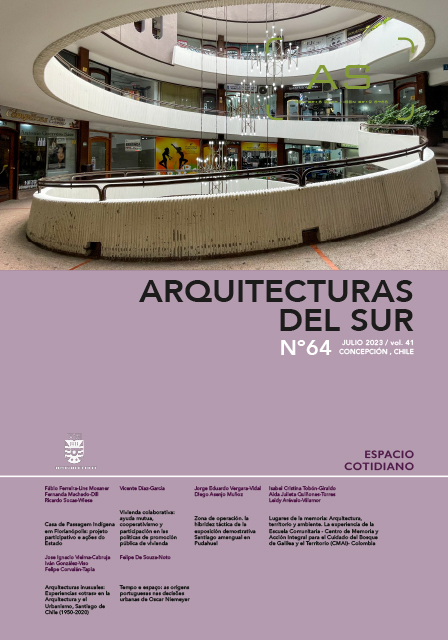Lugares de la memoria: Arquitectura, territorio y ambiente. La experiencia de la Escuela Comunitaria - Centro de Memoria y Acción Integral para el Cuidado del Bosque de Galilea y el Territorio (CMAI)- Colombia
DOI:
https://doi.org/10.22320/07196466.2023.41.064.04Palabras clave:
arquitectura, lugar, memoria, territorio, ambienteResumen
El presente artículo analiza las complejas relaciones de los lugares de memoria desde un enfoque interdisciplinario, con el objetivo de hacer frente a las amenazas extractivistas del sector minero energético y los intereses de los negocios verdes en el Bosque del Galilea. Para ello, se utilizó la metodología cualitativa de Investigación Acción Participativa, en colaboración con los actores sociales del lugar, con el fin de fortalecer los procesos de autogestión territorial en alianza con la Universidad. Asimismo, se profundizó en la comprensión simbólica de la arquitectura como nodo de memoria y cohesión colectiva. Como resultado, se creó la Escuela Comunitaria “Centro de memoria y acción integral para el cuidado del Bosque de Galilea y el Territorio (CMAI)”, que contribuye a las tradiciones sociales y culturales del bosque húmedo premontano de Galilea, en los Andes de Colombia, mediante procesos académicos y científicos en encuentros de saberes. Los resultados del proyecto se reflejan en tres escalas: arquitectónica, territorial y global.
Descargas
Citas
CMAI GALILEA. (2021, October 31). CMAI Tejiendo memoria y territorio: por el cuidado y apropiación del Bosque de Galilea [Video]. YouTube. Recuperado de: https://www.youtube.com/watch?v=sEKZizbxa9U
Corporación Podion. (s.f.). Corporación Podion. Recuperado de: https://podion.org/es/noticia/urge-plan-de-manejo-ambiental-para-proteger-el-bosque-de-galilea
DE CARVALHO, J. J., & FLÓREZ FLÓREZ, J. (2014). Encuentro de saberes: Proyecto para decolonizar el conocimiento universitario eurocéntrico. Nómadas, 41, 131 -147. Recuperado de: https://www.redalyc.org/pdf/1051/105133774009.pdf
ESCOBAR, A. (2003). Mundos y conocimientos de otro modo. El programa de investigación Modernidad/ Colonialidad latinoamericano. Tabula Rasa, 1, 51 - 87. Recuperado de: https://www.redalyc.org/comocitar.oa?id=39600104
FALS-BORDA, O. (1986). Conocimiento y poder popular. Lecciones con campesinos de Nicaragua, México, Colombia. Siglo XXI.
FALS-BORDA, O. (1988). El problema de cómo investigar la realidad para transformarla por la praxis. Tercer Mundo.
HERNANDEZ-SAMPIERI, R., FERNÁNDEZ-COLLADO, C., & BAPTISTA LUCIO, M. (2014). Metodología de la Investigación. Mc Graw Hill.
LA ROSA, M., & MEJÍA, G. (2013). Historia concisa de Colombia (1810 - 2013). Una guía para lectores desprevenidos. Pontificia Universidad Javeriana y Universidad del Rosario.
MUNTAÑOLA, J. (2001). La Arquitectura como lugar. Alfaomega S.A. Universitat Politécnica de Catalunya.
NORA, P. (2008). Les lieux de mémoire. Trilce.
ORTIZ, A. E. (2007). Historia sociopolítica de Cunday y Villarrica. Cunday y Villarrica 1537-1918, una historia anónima. Ediciones Wolfang´s. Ibagué. Recuperado de: https://pcweb.info/libros/1537-1918.pdf
OSTROM, E. (2011). El gobierno de los bienes comunes- La evolución de las Instituciones de acción colectiva. UNAM - CRIM - FCE.
PAPA FRANCISCO. (2015, 18 junio). Laudato Si’: SOBRE EL CUIDADO DE LA CASA COMÚN. Vaticans Encyclicals. Recuperado de: https://www.vatican.va/content/francesco/es/encyclicals/documents/papa-francesco_20150524_enciclica-laudato-si.html
PEÑARANDA, R. (2018). De la memoria a la historia. Colombia en busca de una nueva representación de su pasado. En M. García Villegas, ¿Cómo mejorar a Colombia? 25 ideas para reparar el futuro. (págs. 123 - 133). Ariel, Universidad Nacional de Colombia.
RAHMAN, A., & FALS BORDA, O. (1992). La situación actual y las perspectivas de la IAP en el mundo. En S. M. (coord), La investigación-acción participativa: inicios y desarrollos (págs. 205 - 230). Editorial Popular: Organización de Estados Iberoamericanos para la Educación, la Ciencia y la Cultura: Sociedad Estatal Quinto Centenario.
RICOEUR, P. (2010). La memoria, la historia, el olvido. Trotta.
TODOROV, T. (2008). Los abusos de la memoria. Paidós.
TORRES CARRILLO, A. (2014). Hacer historia desde abajo y desde el sur. Desde abajo.
VALENCIA GUTIÉRREZ, A. (2012). La Violencia en Colombia de M. Guzmán, O. Fals y E. Umaña y las transgresiones al Frente Nacional. Revista Colombiana de Sociología, 35(2), 15-33. Recuperado de: https://revistas.unal.edu.co/index.php/recs/article/view/37195
Descargas
Publicado
Cómo citar
Número
Sección
Licencia
Derechos de autor 2023 Isabel Cristina Tobón-Giraldo, Aida Julieta Quiñones-Torres, Leidy Arévalo-Villamor

Esta obra está bajo una licencia internacional Creative Commons Atribución-CompartirIgual 4.0.
El contenido de los artículos que se publican en cada número de Arquitecturas del Sur, es responsabilidad exclusiva de los autores y no representan necesariamente el pensamiento, ni comprometen la opinión de la Universidad del Bío-Bío.
Las/os autoras/es conservarán sus derechos de autoría, sin embargo, garantizarán a la revista el derecho de primera publicación y difusión de su obra. La publicación del artículo en Arquitecturas del Sur está sujeta a la Licencia de Reconocimiento de Creative Commons CC BY-SA que permite a otros Adaptar: remezclar, transformar y construir sobre el material para cualquier propósito, incluso comercialmente, Compartir: copie y redistribuya el material en cualquier medio o formato, siempre y cuando se reconozcan la autoría y la primera publicación en esta revista citando correctamente, así como también sus nuevas creaciones estén bajo una licencia con los mismos términos.













 Programa de Información Científica/Concurso Fondos de Publicación de Revistas Científicas 2018/ Proyecto Mejoramiento de Visibilidad de Revistas UBB (Código:FP180007)
Programa de Información Científica/Concurso Fondos de Publicación de Revistas Científicas 2018/ Proyecto Mejoramiento de Visibilidad de Revistas UBB (Código:FP180007) 
